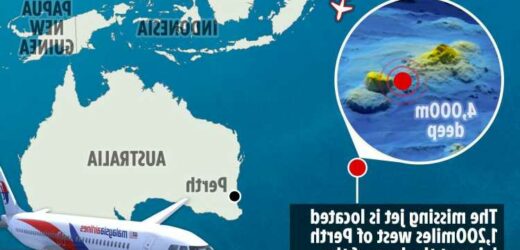A BRITISH engineer says he is "very confident" he has found the exact spot where MH370 crashed.
The missing Malaysian Airlines plane vanished in 2014 with 239 on board en route to Beijing from Kuala Lumpur.
Richard Godfrey has been new tracking technology in a bid to solve one of the greatest aviation mysteries in history.
He claims the system using radio signals acting like "tripwires" has helped him locate the jet which he says lies 13,000ft below the surface of the ocean.
Godfrey says the plane is about 1,200 miles west of Perth, Australia lying at the base of what is known as the Broken Ridge – an underwater plateau with a volcano and ravines in the south-eastern Indian Ocean.
He sensationally told Australia's 7News he believes the crash happened after a “hijacking” which was an “act of terrorism” by pilot Captain Zaharie Ahmad Shah.
The Brit claims the pilot “decided to divert his aircraft and make it disappear in one of the remotest places in the world.”
The engineer said the new tracking system called Weak Signal Propagation Reporter (WSPR) is like having a “bunch of tripwires that work in every direction over the horizon to the other side of the globe.”
Godfrey combined the new technology with satellite communications system data from the plane.
He said: "Together the two systems can be used to detect, identify and localise MH370 during its flight path into the Southern Indian Ocean."
The Brit says he is "very confident" he has found the missing plane which he claims crashed at 8.19am.
“We have quite a lot of data from the satellite, we have oceanography, drift analysis, we have the performance data from Boeing, and now this new technology," he added.
“All four align with one particular point in the Indian Ocean.”
The Broken Ridge location was not in the original 2015 search area and was missed by just 28km by Ocean Infinity in 2018, reports say.
However, according to 7News, the area was part of the 2016 search.
Last month, Godfrey discussed claims that pilot Shah simulated a flight at home where he flew an aircraft into the Indian Ocean "to the point of fuel exhaustion."
He said: "The analysis by Victor Iannello and Yves Guillaume of the Microsoft Flight simulator data found on Zaharie Shah’s extensive home flight computer set up is a smoking gun.
"Zaharie Shah simulated a single flight from Kuala Lumpur via the Malacca Strait to the point of fuel exhaustion in the southern Indian Ocean."
Since 2014, 33 pieces of debris have been found in six countries – including South Africa and Madagascar – which experts believe proves the plane plunged into the Indian Ocean.
The last full-scale search for MH370 in 2018 by US robotics company Ocean Infinity – using unmanned underwater vehicles – covered nearly 50,000 square miles yet nothing was recovered.
Weak Signal Propagation Reporter (WSPR) is now being used to accurately calculate the final location of the MH370 before it disappeared.
WSPR is a grid of radio signals which covers the globe allowing planes to be tracked as they they set off invisible “digital tripwires” which reveal their position.
Extensive trials of new technology tracking historical data of radio signals bumping off planes have led experts to believe it could hone in on a more specific search area.
HUNT FOR MH370
Godfrey compares the technology – set up in 2009 – to a web of invisible detectors that record movement among the clouds.
He told The Times: "Imagine crossing a prairie with invisible trip wires crossing the whole area and going back and forth across the length and breadth.
"Each step you make you tread on particular trip wires and we can locate you at the intersection of the disturbed trip wires. We can track your path as you move across the prairie."
After the news of the successful WSPR trials, the Ocean Infinity team have revealed they are open to resuming another search.
"We are always interested in resuming the search whether as a result of new information or new technology," a spokesman said.
MH370 vanished from radar after taking off from Kuala Lumpur International Airport and took an unexplained U-turn from its planned flight path.
Seven years on, some investigators believe the plane's captain made a series of zig-zagging movements to throw off air traffic teams and evade radar systems.
Source: Read Full Article






